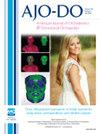正畸治疗中影响下颌第三磨牙预防性拔除的因素:一项横断面研究。
IF 3
2区 医学
Q1 DENTISTRY, ORAL SURGERY & MEDICINE
American Journal of Orthodontics and Dentofacial Orthopedics
Pub Date : 2025-06-01
DOI:10.1016/j.ajodo.2024.12.012
引用次数: 0
摘要
导言:下颌第三磨牙的预防性拔除在正畸学中仍然存在争议,临床决策存在差异。本研究旨在确定影响以色列正畸医生预防性拔牙的因素。方法:采用在线问卷进行横断面调查,调查对象为在以色列执业的88名在职正畸专家和住院医师。问卷评估了人口统计学特征和与预防性拔牙相关的因素。统计分析包括描述性统计、卡方检验、Fisher精确检验、Pearson相关检验、Cochran Q检验和多元逻辑回归。结果:嵌塞特征是预防性拔牙最常考虑的因素(35.2%),其次是下颌弓拥挤(26.1%)。只有4.5%的正畸医生例行转诊患者进行预防性拔牙。人口统计学因素与提取方法之间无显著相关性。年龄与考虑下颌弓拥挤之间存在微弱的微显著正相关(r = 0.21;P = 0.049)。Cochran’s Q检验显示,各因素的优先级存在显著差异(Q = 32.24;结论:建议预防性拔除下颌第三磨牙的决定主要受嵌塞特征和对下颌弓拥挤的担忧的影响,而不是人口因素。这种决策的可变性突出了需要循证指南来支持正畸医生在治疗期间管理第三磨牙。本文章由计算机程序翻译,如有差异,请以英文原文为准。
Factors influencing prophylactic extraction of mandibular third molars in orthodontic practice: A cross-sectional study
Introduction
Prophylactic extraction of mandibular third molars remains controversial in orthodontics, with variability in clinical decision-making. This study aimed to identify the factors influencing prophylactic extraction among Israeli orthodontists.
Methods
A cross-sectional survey was conducted using an online questionnaire distributed to 88 active orthodontic specialists and residents practicing in Israel. The questionnaire assessed the demographic characteristics and factors associated with prophylactic extractions. Statistical analyses included descriptive statistics, chi-square tests, Fisher exact test, Pearson’s correlation, Cochran’s Q test, and multivariate logistic regression.
Results
Impaction characteristics were the most frequently considered factors for prophylactic extraction (35.2%), followed by mandibular arch crowding (26.1%). Only 4.5% of orthodontists routinely referred patients for prophylactic extractions. No significant correlations were found between the demographic factors and extraction practices. A marginally significant and weak positive correlation between age and consideration of mandibular arch crowding (r = 0.21; P = 0.049) was observed. Cochran’s Q test indicated significant differences in the prioritization of factors (Q = 32.24; P <0.001), with impaction characteristics and mandibular arch crowding considered significantly more than future pericoronitis.
Conclusions
The decision to recommend prophylactic extraction of mandibular third molars is primarily influenced by impaction characteristics and concerns about mandibular arch crowding rather than demographic factors. This variability in decision-making highlights the need for evidence-based guidelines to support orthodontists in managing third molars during treatment.
求助全文
通过发布文献求助,成功后即可免费获取论文全文。
去求助
来源期刊
CiteScore
4.80
自引率
13.30%
发文量
432
审稿时长
66 days
期刊介绍:
Published for more than 100 years, the American Journal of Orthodontics and Dentofacial Orthopedics remains the leading orthodontic resource. It is the official publication of the American Association of Orthodontists, its constituent societies, the American Board of Orthodontics, and the College of Diplomates of the American Board of Orthodontics. Each month its readers have access to original peer-reviewed articles that examine all phases of orthodontic treatment. Illustrated throughout, the publication includes tables, color photographs, and statistical data. Coverage includes successful diagnostic procedures, imaging techniques, bracket and archwire materials, extraction and impaction concerns, orthognathic surgery, TMJ disorders, removable appliances, and adult therapy.

 求助内容:
求助内容: 应助结果提醒方式:
应助结果提醒方式:


